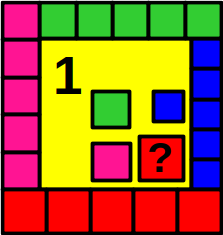Consistency in solving a math challenge
Since mid-2020, I publish every weekend 3 original math challenges that keep the same structure. They are geometric shapes with only one value informed and the other relations defined textually or visually from congruent sides in the image. However, in challenge number 221, something worthy of discussion happened. Because keeping exactly this pattern of development, I got a challenge with a unique solution, but when I published it, I received from two of the most assiduous participants, different answers by coherent methods (the respective challenge below).

In this case, the yellow region joined to 4 small squares forms a square. Knowing that the area of the yellow region is 1, we need to determine the area of a red region.
At the beginning of the way I produced it, the challenge has a unique solution, because from the middle square, I created 5 blue squares to match its side. Then I created 5 green squares to match the yellow side plus one blue side. Finally, I created 5 pink squares to match the yellow side plus one green side (below the original resolution).
Let B be the blue side (blue), G the green side (Green), P the pink side (Pink), R the red side (Red) and Y the yellow side (Y), then:
6B = 5G
6B/5 = G
5B + 6B/5 = 5P
B + 6B/25 = P
(B + 6B/25) + 6B = 5R
6B/125 + 7B/5 = R
1 + (6B/125 + 7B/5)² + (B + 6B/25)² + (6B/5)² + B² = 25B²
B = 125/sqrt(295714)
R² = (6(125/sqrt(295714))/125 + 7(125/sqrt(295714))/5)² = 32761/295714 ~ 0.1107
Okay, though, if we look at the image, we can see that 4 sides of Pink appear to have the same measurement as one side of Yellow. So can we solve the challenge by starting with this relationship? We will see in the following resolution.
Let B be the blue side (blue), G the green side (Green), P the pink side (Pink), R the red side (Red) and Y the yellow side (Y), then:
4P = Y
5P = Y + G
P = G
5G = Y + B
5G = 4G + B
G = B
P = B
But then
4P = Y
5P = Y
P = 0
- From here on, it makes no sense to continue, as all other areas must be 0 and the problem is absurd.
On the other hand, we can look at the image and say that 4 sides of Pink appear to have the same measurement as 5 sides of Blue. So, if we start from this relationship, will we have a solution to the problem? We will see in the following resolution.
Let B be the blue side (blue), G the green side (Green), P the pink side (Pink), R the red side (Red) and Y the yellow side (Y), then:
4P = 5B
P = 5B/4
5P = 6B
5(5B/4) = 6B
25B/4 = 6B
25B/4 = 24B/4
25B = 24B
B = 0
- From here on, it makes no sense to continue, as all other areas must be 0 and the problem is absurd.
Thus, although the problem seems to admit other solutions, or at least other forms of attack. The same when worked lose consistency. That is, their relationships become unsustainable or absurd.
Thus, it is interesting to note that the visual aspect of the problem is not just a way of illustrating the challenge. But it also represents a set of relationships that can escape our superficial perception, while still maintaining a sustainable mathematical structure. Like that trick of splitting a rectangular candy bar so you end up with one more piece than you started with.
This was a mathematical challenge that showed in a subtle way how the pieces of mathematics fit into their set of geometric relationships. So, that other fits, even of apparent coherence, still lead to contradictions.

